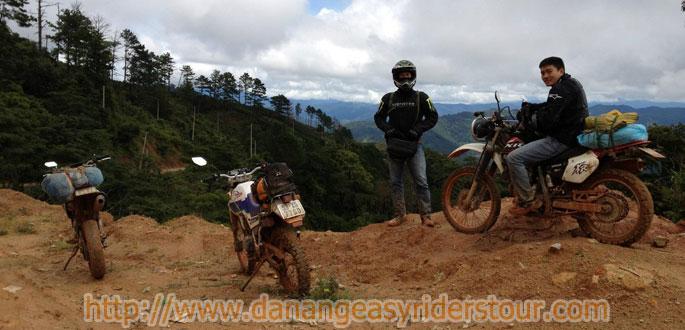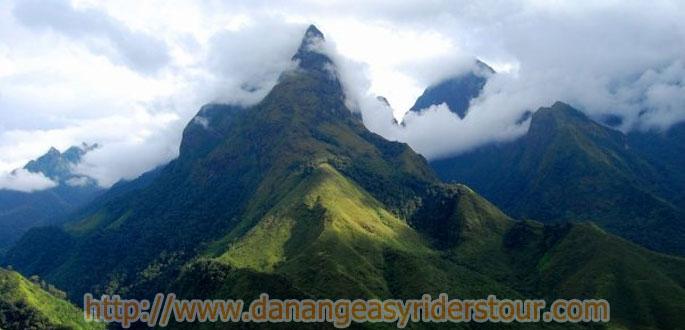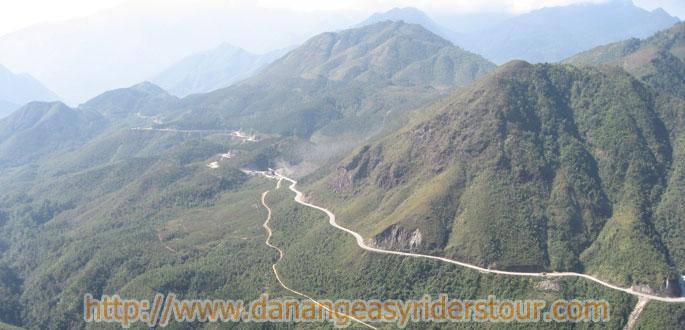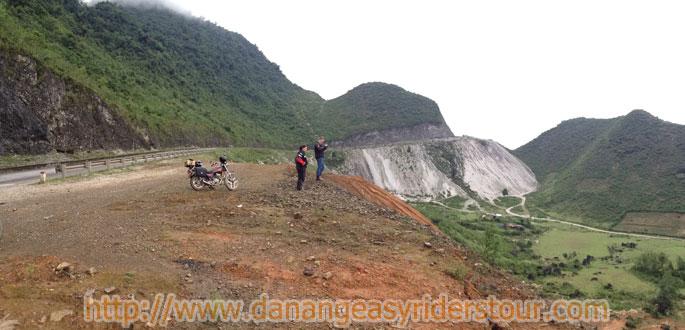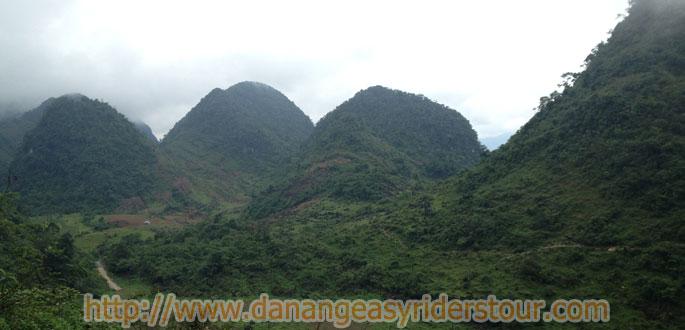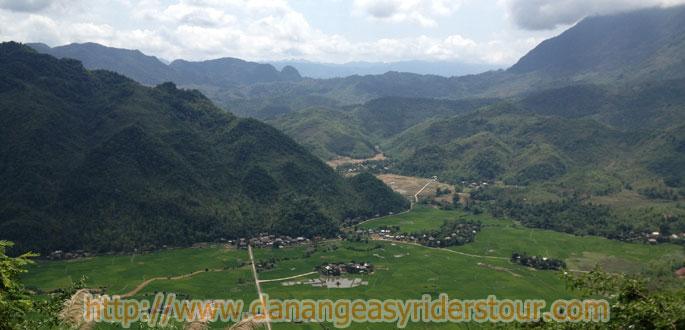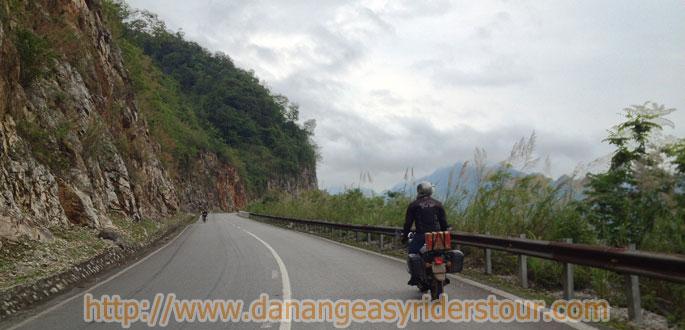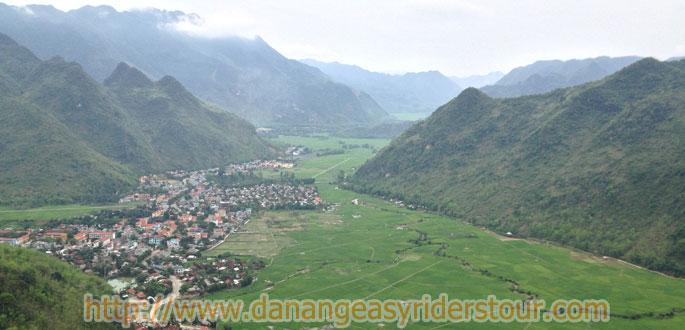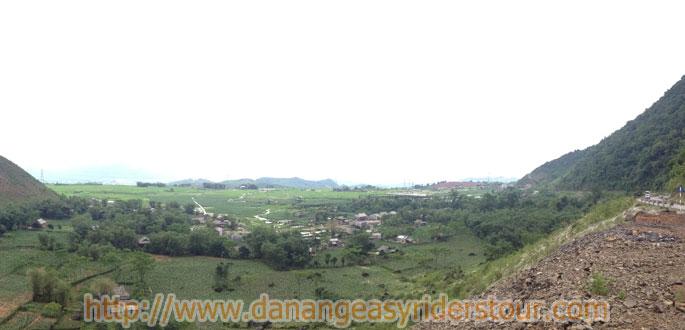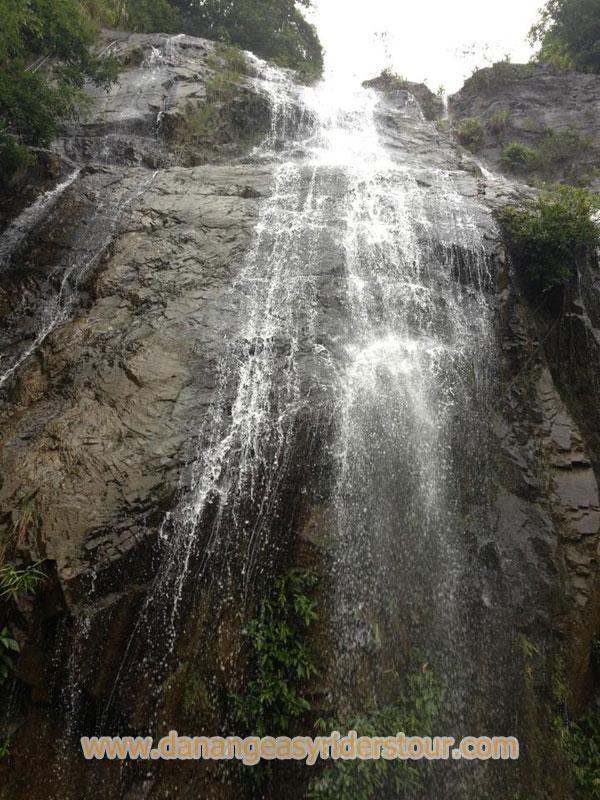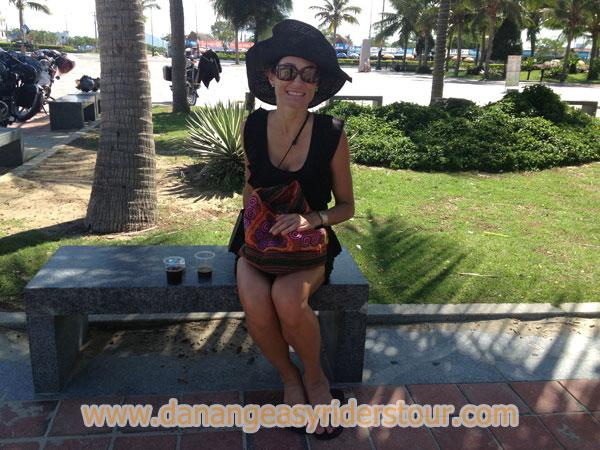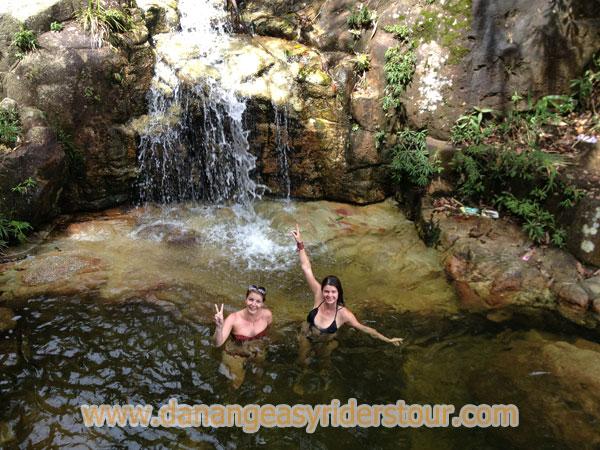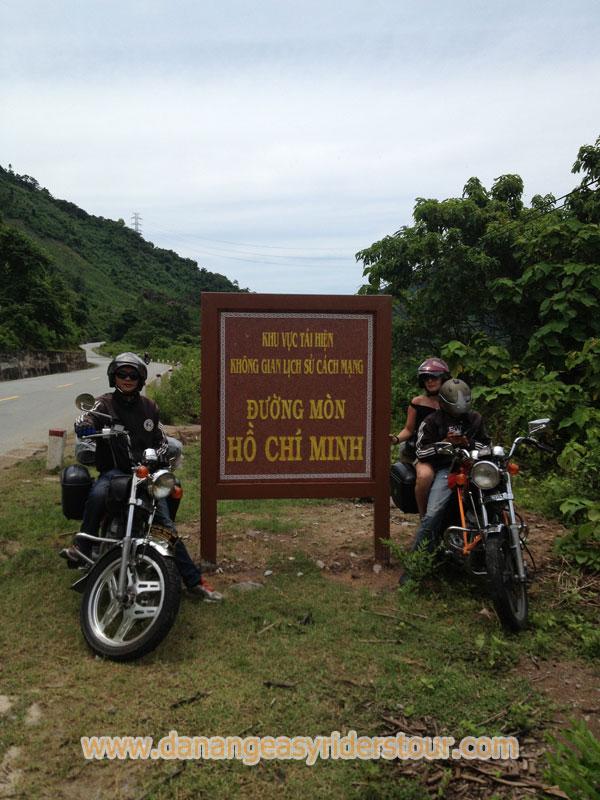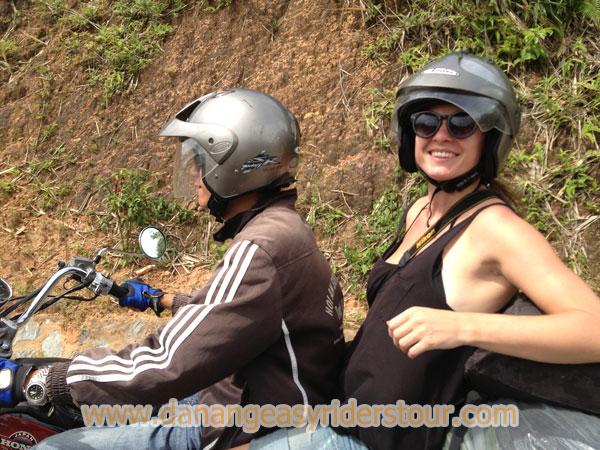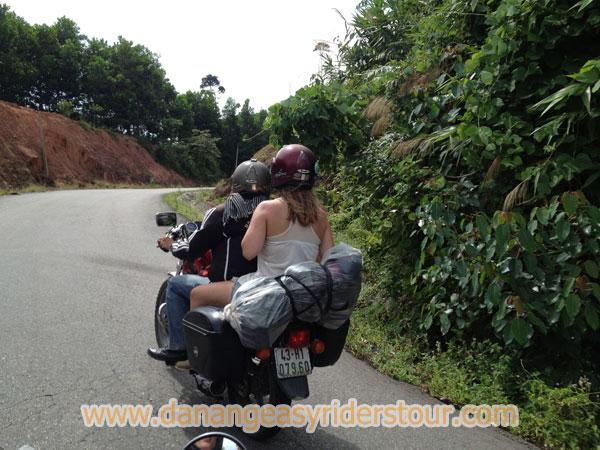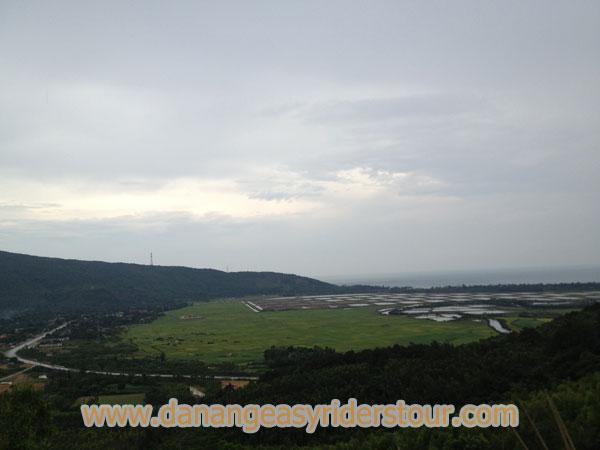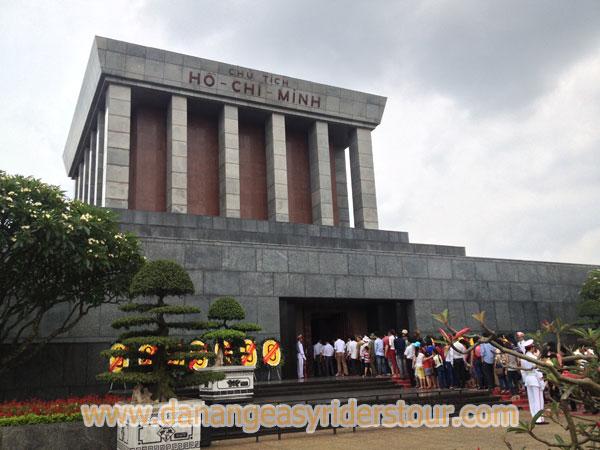Hue is one of places, which has many cultural heritages. Up to now, there is no places like Hue remaining a lot of originally historical vestiges as in this ancient Capital City.
On the Northern bank of Perfume River has relics consisting of palaces, which were constructed as arc defensive ramparts with 11km length. This valuable construction includes more than 100 architectural works which were extremely reflected the life of Emperors and mandarins under Nguyen` reign. Situated in the middle of hills on the Southern bank of Perfume River are very beautiful tombs of Nguyen Kings. Among these tombs are the four famous ones with the name and the arrangements of the tomb reflected each Emperor`s points of view, personality, and tastes. This is majestic Gia Long tomb, imposing Minh Mang tomb, poetic Tu Duc tomb and magnificent Khai Dinh tomb.

Hue is also an important center of Buddhism. In Hue and its surrounding still exist tens of pagodas constructed more 300 years ago, and a hundred of temples and pagodas built in the early century.
Besides, Hue is a place where the royal music is originated, and a place with traditional famous dishes and sophisticated handicraft.
As a unique city of Vietnam still remains its form of City under Middle Age and the constructions of monarchic, Hue has become a big and an invaluable museum. Therefore, vestiges in Hue ancient capital have been classified by the government as a very precious property and on December 1993 Hue has been recognized as a World Cultural Heritage Site by UNESCO.
Climate:
Climate in Hue is different from the Northern and Southern. The climate is harsh and fundamental between provinces in City.
In the coast and delta, the climate is divided into two distinguished seasons: The dry season (from March to August) with the highest temperature is 39,90 C. The rainy season (from August to January the next) with the average temperature is 19,70 C, the lowest temperature is 8,80 C. This season, there is usually daily rain, may be lengthening a week.
In the mountainous region, the climate is cooler, the lowest temperature is 90 C and the highest is 290 C.
Tourists should chose to travel to Hue in the dry season. However, the rainy season has also its attraction. You can walk under rain to fell endless of heaven and earth, poetry of love and life. You also go to restaurant to enjoy hot taste of Hue special dishes. Particularly, you can see drizzle in Hue during some weeks.
If you do not like rain in Hue, you can visit Da Nang, 100km south of Hue to enjoy sunbathing. Although, in this season you will have several nice days between rainy days.

Thien Mu Pagoda:
The name of the pagoda comes from a legend: a long ago, an old woman appeared on the hill where the pagoda stands today. She told local people that a Lord would come and build a Buddhist pagoda for the country`s prosperity. Lord Nguyen Hoang, on hearing that, ordered the construction of the pagoda of the "Heavenly Lady".
The pagoda is situated on Ha Khe hill, on the left bank of the Perfume River, in Huong Long village, 5km from Hue city.
It was built in 1601, and then Lord Nguyen Phuc Tan had it renovated in 1665. In 1710, Lord Nguyen Phuc Chu had a great bell cast (2.5m high, 3.285kg) and in 1715, he had a stele (2.58 m high) erected on the back of a marble tortoise.
Several kings of the Nguyen Dynasty such as Gia Long, Minh Mang, Thieu Tri and Thanh Thai, all had the pagoda restored. Phuoc Duyen tower (at first called Tu Nhan tower) was erected in 1884 by King Thieu Tri. This octagonal tower has seven storeys (2m high). Dai Hung shrine, the main-hall, presents a magnificent architecture. As well as bronze cast statues, it shelters some precious antiques: the bronze gong cast in 1677, the wooden gilded board with Lord Nguyen Phuc Chu`s inscriptions (1714). On both sides of the pagoda are a room for the bonzes and a guest-room for visitors.
The pagoda is surrounded by flowers and ornamental plants. At the far end of the garden stretches a calm and romantic pine-tree forest.
The pagoda was heavily damaged in 1943. Bonze Thich Don Hau hence organised a great renovation of the pagoda, that lasted for more than 30 years.
Nowadays the pagoda is very well-maintained and very welcoming to all visitors.
Dieu De Pagoda:
The pagoda is located at 100 Bach Dang street, Phu Cat district, in Hue city.
It was built by King Thieu Tri in 1844 on the platform (5,000m2) of his old residence, where he was born in 1807.
The pagoda was constructed on a large scale, but was badly damaged during the successive wars. In 1889, Bonze Tam Truyen was granted fund by King Thanh Thai to restore the pagoda, but once again, it was badly damaged during a storm, in 1904. The present construction was made in 1953. The pagoda includes a main sanctuary with two statues of the Eight Vajra Deities. Behind the pagoda is a guest-room and a kitchen. In the courtyard stand a stele house and a bell tower. The two-storey entrance gate is topped with Dhamma Guardian`s pavilion.
Located between Dong Ba and Gia Hoi bridge, the pagoda attracts many visitors.
Dieu De was the third site listed by King Thieu Tri in the 20 beauty spots of Hue.
Tu Dam Pagoda:
Tu Dam pagoda is one of the biggest pagodas in Hue. The pagoda was founded at the end of the 17th century (in about 1695) by the Venerable Minh Hoang Tu Dung, a Chinese who belonged to the 34th sect of the Lam Te school of Zen. He was the high-ranking monk who taught and gave the certification to monk Lieu Quan, the Buddhist initiator of Vietnam in the South.
Tu Dam pagoda is now in the district of Truong An, on a beautiful piece of land: high, wide and flat. The pagoda is only 2km from the centre of Hue city, along Dien Bien Phu street, across Nam Giao Bridge up to the end of the first slope. The pagoda has a south-east orientation. Kim Phung mount in the front served as a natural wind-screen. Linh Quang pagoda and the temple dedicated to respectable patriot Phan Boi Chau stand on the left, and Thien Minh pagoda, in the back.
Tu Dam is not the biggest nor the oldest pagoda in the country, but it is famous and nationally known for its important role in the process of development of Buddhism, and the struggle for peace and for freedom of religion.
Tu Dam pagoda was designed following the model of a conference pagoda (Chua Hoi). The old and new architectures blend together creating spacious and harmonious elements. The three main parts of the pagoda are the three entrance gate, the main sanctuary and the conference House.
The gate is high and wide with a tiled roof. Just inside the gate is a big bodhi tree, providing shadow all year around. As a branch, this bodhi tree was taken right from the bodhi tree under which Buddha reached Nirvana. Mrs Karpeies, Head of the French Buddhist Association, brought it back from India as a present offered to the pagoda and planted it there in 1936. The pagoda yard was built on a very large surface so that it can provide enough space for thousands of people. Every year, on Buddha`s birthday, it is a gathering place where many important and most crowded festivals of Hue`s Buddhists take place.
The main sanctuary consists of a service hall and an ancestors` altar. The service hall was built on a marble foundation 1.5m high with an old style roof forming a towering and impressive pagoda. On the edge and top of the roof are many curving, gentle, symmetric pairs of dragons creating a well-balanced and harmonious beauty. Under the ancient roof are frescoes telling Buddha`s stories. Many long couplets are hung on the pillars of the Service hall. The building is flanked by two stele and drum towers.
Tu Dam pagoda worships one Buddha only, so that its appointments are rather simpler than that of other pagodas in Hue. In the temple, there is a Buddha Sakyamuni sitting on a lotus pedestal. There are an ancestors` altar house and a monks` house behind the main temple. The two storey Conference Hall is large and wide building with 10 rooms to meet the requirements of a conference pagoda.
Tu Hieu Pagoda:
The pagoda is located at Duong Xuan Thuong III hamlet, in Thuy Xuan village, 5km southwest of Hue. It faces the southeast and uses Ngu Binh mount as a front screen.
The pagoda was originally a small hut built by Nhat Dinh in 1843, who was formerly recognized by royal authority as the monk of Giac Hoang Pagoda. In 1848, the pagoda was restored by monk Cung Ky with the help of the king`s eunuchs and courtiers. Tu Hieu hence became a large pagoda.
In 1894, it was rebuilt by Cuong Ky with the support of King Thanh Thai and the King`s eunuchs created the half-moon lake. In 1962, the pagoda was renovated by Most Ven. Chon Thiet. And in 1971 the three entrance gate and the staff houses were rehabilitated by senior monk Chi Niem.
The pagoda was built in the shape of the Chinese character "Khau" (mouth), with the main building consisting of three rooms and two wings. The main sanctuary is devoted to the worship of Buddha. Behind there is a room honoring former monks of the pagoda. Across a courtyard, the Quang Hieu Duong Hall houses an altar dedicated to local Buddhist devotees on the right, another to the deity Quan Cong in the center, and a third to the eunuchs on the left. A separate altar in this hall honors Le Van Duyet, an outstanding mandarin during the reign of Emperor Gia Long. On the left side of the courtyard are the living quarters of the monks (Ta Lac Thien) and to Tu Hieu right is the guest-house (Huu Ai Nhat).
The entrance gate to the pagoda is a curved two storey structure. On the second storey, a statue of the guardian spirit Ho Phap protects the pagoda. Inside the gate is a crescent-lotus pond. On both sides of the courtyard are stele houses engraved with the history of the pagoda.

Redeemer Church:
The Cathedral was built in 1937 and completed in 1942. The Cathedral located at the end of Nguyen Hue street, in Hue City.
The particular architecture of the cathedral is its large doors without partitions. The verandah of the Cathedral is largely designed in order to make who ever stay in the verandah, feel that they were in the interior of the church.
Main altar is made of rose marble and its bloc is 3.6m long, 1.25 m wide and 2.8 m high. Near by the main altar, there are two smaller ones also made of rose marble in bloc. In the Cathedral, there are drums, gongs deeply characterizing East-Asian characters.
Beyond the verandah, there is a small room to maintain remains of dead Christians ashes in small earthenware for worshipping (with burning incense stick).
The campanile consists of four bells operated by electricity. The Cathedral of the Redeemer has its pointed cone stretching out to the sky and its main roof is covered by tiles, all of those show the combination of western and eastern architecture in design and construction. This is a cathedral of fine architecture in Hue City.
Phu Cam Main Cathedral:
Phu Cam main Cathedral is situated at Phuoc Vinh, Hue City. The Cathedral was built with modern architecture, designed by the architect Ngo Viet Duc.
In early 1963, the construction of the Cathedral was built. To 1967 only the Saint Palace was built and then to 1965, the Cathedral was basically completed .Phu Cam cathedral was built by new concept of physical structure. Supporting pillars were concreted closely attached to the walls and gradually and supplely bended ahead. The three supporting pillars at each of four corners stretch out and create a fairly large space to embrace the whole of Saint Palace and Saint Altar.
The interior of the Cathedral was built following classical tradition with Latin Holy Cross and two opening doors. There are two row of color glass windows located in the upper interior of the Cathedral and in the middle, there is a Holy Cross made of steel and concrete.
The Saint Palace is a round shape with foot steps and on the top there is a smaller round shape with the altar made of marble bloc. Temporary house was closely built to the backstage of the cathedral fitted in the concave part behind and settle on a high platform in the center.
In the two wings of the crucifix, there is the tomb of the former archbishop Philipe Nguyen Kim Dien (1921-1988) in the left and in the opposite right - the altar for presenting the Saint.
In front of the Phu Cam main cathedral there are two molding statues: the Saint Phero is in the right, and in the left is Saint Paulo and other missionaries of the Phu Cam diocese. The open-space of Phu Cam main cathedral looks like an opening-mouth-dragon and in general Phu Cam cathedral with its top perpendicularly stretching to the sky is very purified and full of artistic and religious characters.
Ngu Binh Mount:
The annals "Dai Nam Nhat Thong Chi" by the History Department of the Nguyen Dynasty wrote about Ngu Binh Mount as follows: "In the north-east of Huong Thuy emerges an even surface serving as a screen, a first bar in front of the citadel.
It was called Nui Bang (Even Mount) and renamed Ngu Binh in Gia Long`s reign. Its top is flat with pine trees every where".
The 105m Ngu Binh has a striking and symmetric figure. On both sides of the Even Mount (Bang Son) are 2 small mounts called Ta Bat Son (Left Mount) and Huu Bat Son (Right Mount). The Nguyen dynasty was established and decided to build up the Hue Capital. When seeing that Bang Son look like a front screen. Gia Long Emperor approved the design of geo-mancers: To choose this mount as a front altar of the imposing and solid defending wall system, and renamed it Ngu Binh.
Together with the Perfume river, Ngu Binh Mount is the second invaluable gift endowed by Nature to Hue. These two mingle with each other creating the romantic mountain and river beauty of Hue. For a long time, this beautiful mount and the blue limpid Perfume river have become the symbol of Hue city. Therefore, people often call Hue "The land of the Perfume river and Ngu Binh mount" or "Huong-Ngu Land".
For many centuries, many generations of poets and travelers have recognized it a wonderful place to admire nature. On fine days, from the top of Ngu Binh mount, people can view all the sights of Hue city with magnificent palaces, ancient pagoda roofs and the blue limpid Perfume river winding in and out... Right in front of people`s eyesight stretch boundless pine forests on the hills and large plains of Huong Thuy, Phu Vang, Huong Tra districts with green plants and trees. In the distance is the endless dark purple Truong Son range hidden behind silver clouds... Towards the east is a dim white sand strip and Thuan An estuary in the distance with the deep blue Eastern Sea.
Some kilometers away from Ngu Binh mount is Vong Canh hill, another beautiful spot of Hue which reflects itself charmingly in the Perfume river, opposite to Ngoc Tran Mount. From the Vong Canh Hill, people can behold green fruit gardens with areca palm, longan, orange, mandarin, grape fruit shades, etc. Mingling with pine trees, grey roofs of pagodas and temples, as well as the ancient and meditative tombs,... The Perfume river looks like a soft silk strip winding at the foot of the hill. Once tourists come here at mist fading dawn or in sunset, they will understanding and be heartfelt the romantic beauty of a hill, a river, a corner of Hue`s sky...
Vong Canh Hill:
Vong Canh hill is 7 km from the center of Hue. It is not so beautiful and well-known as Mount Ngu. Still, as it is called, standing from the top of Vong Canh Hill, tourists can enjoy the lovely panorama of Hue especially the Nguyen Dynasty`s tombs.
Bach Ma Mountain:
Bach Ma (White Horse) Mount is 60 km south of Hue city. It is still a famous resort. It is about 1,450m above sea level in a transition zone of the northern and southern climate, so it bears a temperate climate, similar to Sapa, Tam Dao, Da Lat, etc. There, the green vegetation is abundant all the year round. The animals are also rich with chirps and calls all days and nights which sound both wild and familiar...
Bach Ma Mount also has many limpid brooks and picturesque waterfalls. At the 16th kilometer on Cau Hai - Bach Ma road, turning left and walk for 20 to 30 minutes, tourists will also find 400m high, 20m wide Do Quyen waterfall which suddenly appears as if it were suspended in the sky... In the summer, rhododendron flowers are blooming on both sides of the fall like two huge flowery silk carpets. In the centre of the resort is Bac (Silver)waterfall, only 10m high and 40m wide and look like a spotless white curtain swayed by the wind.
More than half a century ago, the French recognized the beauty of Bach Ma and began to develop it. Within 5 years (1942-1946), 139 villas were continuously built under the foliage of old trees and by sheer cliffs.
From the top of Bach Ma, people can view landscapes of Hai Van Pass, Tuy Van mount, Cau Hai lagoon with heaving fishing boats and even the shimmering electrical lights of Hue city at night as well as the huge and boundless Eastern Sea.
Perfume River:
The Perfume River have two sources. They come from the Truong Son range: the Ta Trach (Left Tributary) from Truong Dong mounts toward north-west through 55 impressive waterfalls, and then slowly to Bang Lang fork; the shorter Huu Trach (Right Tributary) flowing through 14 dangerous waterfalls and Tuan ferry landing to Bang Lang fork where the two tributaries join to form the poetic Perfume river.
From Bang Lang to Thuan An estuary, the Perfume river is 30 km long (The river level is not much above that of the sea) so that the river runs very slowly.
The color of the Perfume river is darker when it winds along the foot of Ngoc Tran mount - the Jade Cup Temple - where there is a very deep abyss.
The Perfume River is beautiful sight from its source, and winds among mountains, forest trees, plants, etc. bringing with it fragrances of tropical flora. The river runs slowly through the verdant and shady villages of Kim Long, Nguyet Bieu, Vy Da, Dong Ba, Gia Hoi, Dinh market, Nam Pho, Bao Vinh, mingling with the odors of flowers of Hue... The river with the shimmer blue limpid color is like a pearl in the sun. Hue boats rowing up and down with remote, meditative and deep folk melodies at deep night. It is an eternal pleasure for many generations of tourists who go boating to behold the poetic landscape, to listen to the folk melodies of Hue in tranquil nights.
The views on both sides of the river with the citadel, town, gardens, pagodas, towers and temples, etc. and their reflections in the waters make the already loveable river even more poetic and musical. Many people think that Hue city has peaceful, gentle and tranquil landscapes mostly thanks to the Perfume river. This river brings to the city a meditative poetic characteristics and the harmonious limpidity exhaling from a land of age-old culture.
The 105m Ngu Binh has a striking and symmetric figure. On both sides of the Even Mount (Bang Son) are 2 small mounts called Ta Bat Son (Left Mount) and Huu Bat Son (Right Mount). The Nguyen dynasty was established and decided to build up the Hue Capital. When seeing that Bang Son look like a front screen. Gia Long Emperor approved the design of geo-mancers: to choose this mount as a front altar of the imposing and solid defending wall system, and renamed it Ngu Binh.
Together with the Perfume river, Ngu Binh Mount is the second invaluable gift endowed by Nature to Hue. These two mingle with each other creating the romantic mountain and river beauty of Hue. For a long time, this beautiful mount and the blue limpid Perfume river have become the symbol of Hue city. Therefore, people often call Hue "The land of the Perfume river and Ngu Binh mount" or "Huong-Ngu Land".
Thuan An Beach:
Thuan An beach is situated near by Thuan An mouth, where Huong River runs to Tam Giang lagoon and then to the sea...
In the beginning of the 19th century, King Minh Mang named the place as Thuan An, assigned to build Tran Hai frontier post for the defense of the Capital.
Far from Hue 15 km, only 15 minutes by car, tourists are able to reach the beach. Plenty small boats, junks drift up an down the river in the left of the route, and on the right there are houses, temples, pagodas, rice field, and gardens successively spread out....
Thuan An is a very enjoyable place for all tourists after a full day to visit Citadel, mausoleums, pagodas, and Hue scenery... Thuan An is also the place, where Hue people gather to enjoy the fresh air and sea-bathing in summer time. Intensive activities of the beach lasts from April to September, while Hue temperature being fairly hot.
Sometimes, tourists are very crowded, and there are not enough places for their camping.
Besides sea bathing, tourists are able to visit Thai Duong temple, where Thai Duong Goddess is very esteemed by villagers or visit the temple devoted to the whale, the sacred animal of the local people.
Lang Co Beach:
With its 10 km in length, Lang Co beach bordered a section of the 1A National Highway, nearly Hai Van pass, and 24 km from Bach Ma area. With its gradually slopping, white sand beach, the average depth of under 1m and the average temperature in the bathing season of 25°C, Lang Co is an ideal beach for tourists.
In Lang Co sea, there are various kind of shrimps, lobster, sea shrimp, crab, butter-fish, mackerel fish, oysters...
Not far from the beach, there is Chan May scenery, Lang Co fishing village.
Canh Duong Beach:
Canh Duong is the most beautiful beach of Thua Thien Hue, about 60 km from Hue city. With the length of 8 km, 200m wide, bended in arc shape, located between the two mountains: Western Chan May and Eastern Chan May, all those create a very beautiful and attractive landscape.
Gradually sloping beach, white and fine sand, transparent and limpid sea water and fairly windless, the beach is ideal for all activities of tourism and sport.
Tam Giang Lagoon:
The Thua Thien Hue plain along the sea coast has many lagoons, such as those of Tam Giang, Thuy Tu, Lap An, into them are converged the water of almost all the rivers of the province of Thua Thien Hue before going to the sea, through the mouths of Thuan An, Tu Hien, or through the great lagoon of Lang Co.
Tam Giang and Cau Hai are the 2 biggest lagoons with fresh water, the 2 most representative lagoons in Vietnam with a length of 70 km for the whole of the two, they form an ideal habitant for many sea species all along the province.
The lagoon of Tam Giang has a depth of 2 - 4m, in some places, of 7m, the immense water surface is an area of important economic activity bringing high income with its sea products. Yearly thousands tons of sea products are brought on here (fish, shrimps and others). In the recent years, the cultivation and raising of sea products, mainly the raising of shrimps and cultivation of "gracilaria" has developed in this zone of lagoons. Today the province is researching on investment for building a bridge through the Tam Giang lagoon in order to have favorable conditions to develop the economy and tourism of this region.
"Ho Quyen" - Tiger`s Arena:
Ho Quyen was the arena where duels between elephants and tigers were arranged for the entertainment of the Emperor, the royal family and mandarins..
Ho Quyen was built in 1830 on the south bank of the Perfume river and 4 km from the citadel. It is a unique construction, open air and solidly built as a citadel. The coliseum consists of two concentric circles built with bricks and mortar. The first staircase with 20 steps was exclusively reserved for the
Emperor and royal family leading up to the rectangular tribune with the surface of 96m sq. the height of 1.5m in comparison with the path surface. Looking down from the tribune, people can see the cavity with the coliseum. The second staircase, with 15 steps was used by the soldiers and the common people leading up to the earthen part. Between the two staircases is a big entrance 1.9 m wide and 3.9 m high for the elephants to enter the coliseum. .

The way running around above this curved door is narrowed into a small bridge across the curved door. Under it is a big two-wing wooden door with stone hinges which still remain undamaged.
Opposite to the tribune for the Emperor on the other side of the arena are five cages for tigers and leopards. Above the middle cage is a stone sign inscribed the two Chinese words "Ho Quyen".
The duel between elephants and tigers is a long standing entertainment for Emperors and Lords.
In the old time, the duels Ho Quyen were held once a year. The last one was organized here in 1904 in Thanh Thai`s reign.
The Tiger`s arena is a unique architectural work rarely found in South East Asia.
Though it is not as huge as the arenas of the Emperor Romance but it still bears an outstanding figure and creates a martial and imposing atmosphere.
Hue Temple of Letters:
The Temple of Letters is a worship temple founded by the Nguyen dynasty to dedicate to celebrated scholars of Confucianism.
Formerly, various Temple of Letters were built by the Nguyen Lords in the capital and moved to three different places: Trieu Son village, Luong Quang village and Long Ho village.
In 1808, Gia Long and his Imperial Court decided to choose a low hill beyond the Heavenly Lady pagoda, on the left bank of the Perfume river, i.e. the current position, to built a new imposing and striking Temple of Letters. At that time, the National University was also established there and operated until 1908 before it was moved into the citadel. The construction of the Temple of Letters was commenced on 17th April 1808 and finished on 12th November 1808.
The Temple of Letters faces south. All main constructive works were built on the top of the hill, three meters higher than the surrounding land. In front of it was the Perfume river, in the back were villages, hills and mounts spreading from Truong Son range, surrounded the back of Temple of Letters. All items of Hue Temple of Letters were erected on a square surface of 160 m long on each side enclosed by La Thanh (surrounding wall). There was once a complex of 50 big and small constructions including 32 steles which bore names of doctors and four other steles.
The Temple of Letters was many times renovated and many sub- constructions were built, especially in Minh Mang and Thieu Tri`s time. From Minh Mang`s time onwards, National Examinations were held so that steles bearing the names of successful candidates were erected here.
These "Tien si de danh bia" - "Steles bearing doctors` names" were gradually erected on the yard of the main temple from 1831 to 1919, the year in which the last National Examinations was held in Khai Dinh`s time.
As destroyed by the war and weather, the remains of the Temple of Letters are now the 34 steles of great cultural and historic value.
On these steles are names, ages and places of birth of 239 successful candidates in National Examinations organized in the Nguyen dynasties.
Hue Temple of Letters is a valuable historic remains. To visit Van Mieu, tourists can understand more about the tradition of knowledge appreciation, scholars administration and study encouragement of our ancestors from the old time.
Hon Chen Temple:
Standing just on the bank of the Perfume River inclined to poetic dreams and 10 km upstream of Hue, the Hon Chen temple for cult of Po Nagar, the Goddess of the ancient Cham minority. After then, the Vietnamese continued the cult and name the Goddess as Heaven Goddess Y A Na.
This temple for Goddess appeared in this place centuries ago, but with a very simple design, and after then, reconstructed with a larger and more beautiful architectural scale in 1886.
The Hon Chen temple is situated at a lovely site seated on the slope of the mountain Ngoc Tran (Jade-cup) with sheer cliff and mirroring in the deep blue water of the Perfume River.
Thanh Toan Tile - Roofed Bridge:
The Thanh Toan tile-roofed Bridge crosses a canal flowing from the beginning to the end of Thanh Toan village, Thuy Thanh Commune, Huong Thuy district at present. The village is about 8 km from Hue city on the eastward.
Thanh Thuy village was established in the 16th century. Among the emigrants from Thanh Hoa following Lord Nguyen Hoang to Thuan Hoa, there were 12 family heads who settled down there to be the 12 initial families of the village. One niece of the sixth generation of the Tran family - Mrs. Tran Thi Dao - offered the fund to the village to build a wooden bridge so that the villagers on both sides of the canal could transport conveniently and benighted travelers could rest on their way. Mrs. Tran Thi Dao was a childless wife of a high-rank mandarin in Le Hien Tong reign. She wanted to used her money for charity. In Canh Hung 37th year, Emperor Le Hien Tong granted the village a document to praise Mrs Tran Thi Dao and exempted the villagers from many taxes for them to remember her and to live after her example. In 1925, Emperor Khai Dinh also granted a document to bestow her "Duc Bao, Trung Hung Linh Pho" and to order the villagers to set up an altar on the bridge to worship her.
The tile-roofed Thanh Toan is an arched wooden bridge, 17m long and 4m wide. On both sides of the bridge length are 2 rows of wooden flat forms and parapets for people to lean their backs. The bridge is roofed with tubes. A researcher into Vietnamese ancient aesthetics - Louis Bezacier - classified Thanh Toan a rare and the most aesthetically valuable bridge among those of Vietnam. In the first half of the 20th century, there were the two most famous bridges of this style Phuc Toai and Phu Khe in the north, Thanh Toan in Hue and Nhat Ban (i.e. Lai Vien Kieu, also called Chua Cau) in Hoi An. The roofs of the bridges in the north are made of flat tiles, in the centre are made of tube tiles.
The tile-roofed Thanh Toan bridge is not only an ancient architectural remain with highly historic and cultural values but also a tourist attraction. The bridge was built over 2 centuries ago and damaged many times by storms, floods and wars. However, after the bridge was destroyed, the villagers always contributed to repair, renovate and preserve it. The Thanh Toan bridge with its tile-roof has entered into the moods and aspirations of many generations as well as inspired the poetic souls of the local people and travelers, their contents are still handed down among the people or engraved right on the bridge.
In September 1991, the bridge was greatly renovated according to the old design and officially accepted by the Cultural Ministry as a national remains, a rare and appreciated beauty-spot of the whole country.
Hue Quoc Hoc School:
Quoc Hoc High school was founded pursuant to the royal decree dated September 17th 1896 (the 8th year of Thanh Thai reign) and the decree on November 18th 1896 of the French Resident-Superior in Indochina. The school was built on the site of a former squadron headquarter - a royal navy headquarters (1806 or the 5th year of Gia Long`s reign).
Quoc Hoc High school was founded in order to train those who would serve the feudal colonial government, so in the study curricula then, French was the main subject. The conditions of the students accepted by Quoc Hoc High school:
- The sons of the King`s relatives.
- The sons of royal families.
- The mandarin`s sons.
- The students of Thanh Nhon school and Quoc Tu Giam school.
In 1915, when the decree annulling Emperor ancient exam in the province and the ancient exam of the capital in the North was issued, Quoc Hoc High school was rebuilt. The rows of thatch roofed apartments were torn down and replaced by two rows of buildings, the walls made of brick, the roof covered with tiles. It was solid, and comfortable according to the western European architecture. Most of the architectures are still extant.
In 1932, the school opened many specialized classes and its name was changed into Khai Dinh Lycee. During the resistance against French Colonialists on December 19th 1946, the school was moved into two places and followed the resistance.
- One branch: the 1st stage with the name "Binh Tri Thien school" was situated in Huong Khe, Ha Tinh province.
- The branch of 2nd stage school with the name "Huynh Thuc Khang school", was situated in Duc Tho, Ha Tinh Province. The branch returned to Hue after ten years of interruption, and was occupied by colonialists as a barrack on April 29th 1955, the school was restored and has resumed normal operation.
Hermitage Bien Duc Thien An:
The Hermitage Bien Duc Thien An, usually name Thien Duc Hermitage, has been founded in Summer 1940 by the Bien Duc French hermits with the name of Thien An (Peace from Heaven). The Hermitage is situated on the Thien An Hill - the name of the hill comes from that of the Hermitage. Before the hermitage managed also an infirmary and a school; the students by now have become cadres mainly of the locality. To day the hermitage is only a place for religious formation.
The hermitage is surrounded by a quiet pine forest, situated between the tomb of Thieu Tri and that of Ming Mang, about 6 km from the ancient capital Hue, in the South - Western direction. Walking in this Thien An pine hill, the tourist would think he is somewhere in the forests around Da Lat. Here is the Thuy Tien lake, and there the Luu Ly lake, all this contribute to enhance the charm, the poetic and dreamy spell of the Thien An hill, making it a tourism and entertainment site, and a picnicking zone for schoolboys and students.
The heritage with this quiet and silent environment helps its members to deepen in their religious meditations, and also creates more favorable conditions to all those who come here to fray and search for peace of mind.
Dynastic Temple The Mieu:
Situated southwest of the Citadel and facing south, The Mieu Temple is dedicated to ten Emperors of the Nguyen dynasty. Built by Emperor Minh Mang in 1821, it presents a 9-compartment main building and a 11-compartment front building, together connected in the "double" architecture with two bays on east and west sides It is roofed with yellow enameled tiles and on the ridge rests a wine gourd decorated with Phap Lam enamel.
The Mieu Temple once had seven red and yellow lacquered altars (one in the middle, three on either side).
The middle altar was dedicated to Emperor Gia Long and his two Queens (Thua Thien and Thuan Thien).
The first altar (left) was dedicated to Emperor Minh Mang and Queen.
The first altar (right) was dedicated to Emperor Thieu Tri and Queen.
The second altar (left) was dedicated to Emperor Tu Duc and Queen.
The second altar (right) was dedicated to Emperor Kien Phuc.
The third altar (left) was dedicated to Emperor Dong Khanh and Queen.
The third altar (right) was dedicated to Emperor Khai Dinh.
On January 25, 1959, at the request of the royal family and the people, a ceremony was held to admit to the temple mortuary tablets of Ham Nghi, Thanh Thai, and Duy Tan, three anti-French Emperors. So, there are today three additional reddish-lacquered altars for them in the temple.
East of the temple is the Canh Y Palace. West of it is a square-shaped chapel for the worship of the God of Earth. A wall runs all around The Mieu Temple with the Khai Dich Gate (Gate of Bringing Up) on the east, the Sung Thanh Gate (Gate of Peace Honoring) on the west, the Hien Huu Gate (Gate of Recognizable Assistance) (left) and Doc Huu Gate (Gate of Genuine Assistance) (right) at the back.
In the yard of the temple stand the Nine Dynasty Urns. Behind them is a wall with the Hien Lam Pavilion (Pavilion of Glorious Coming) in the middle. Left of this pavilion is the Tuan Liet Gate (Gate of Grandness) topped by a belfry and right of it is the Sung Cong Gate (Gate of Honorable Achievements) with a drum-tower atop (The temple is architecturally similar to Thai Temple).
Outside of the Hien Lam Pavilion are the Left and Right Houses, dedicated to meritorious mandarins who had devoted themselves to Nguyen Anh (later known as Emperor Gia Long) and his successors.
The Left House honors the four royal family members Ton That Man, Ton That Dien, Ton That Huy, and Ton That Hoi.
The Right House is dedicated to Vo Van Tanh, Ngo Tung Chau, Chau Van Tien, Vo Di Nguy, Nguyen Van Truong, Pham Van Nhon, Nguyen Huynh Duc, Tong Phuc Dam, Nguyen Van Man, Do Van Huu, Nguyen Van Nhon, Mai Duc Nghi, and Truong Dang Que, accepted by Emperor Minh Mang in 1827.
Farther is the main entrance to the temple guarded by two stone Kylins (mythical animals)
Many personal paraphernalia of great value which belonged to the Nguyen Emperors are kept in the temple. On each altar were once dozens of gold ingots. Fortunately enough, the temple has suffered the least damage through the numerous wars and today visitors can see it as it was originally built.
The Flag Tower:
The Flag Tower, also called the King`s Knight, is the focal point of Hue city. It is commonly known as a flagpole, but viewed from the Imperial City, it is really a huge structure of three flat-top pyramids, one lying on top of another.
It was built during Emperor Gia Long`s reign, in 1807, and later improved by his son, Emperor Minh Mang. According to the Thuc Luc (Nguyen Dynasty`s Chronicle), the flag-tower is 17.40 m high and consists of three terraces. The first is 5.60 m high, the second ,5.8 m, and the third, 6 m. The higher the terrace, the smaller its surface. On the third terrace, are 8 little buildings housing one canon each and two sentry-boxes at opposite ends.
The 29.52m flag-staff was originally made of wood. It was replaced by a new one in 1846 by Emperor Thieu Tri and again in 1914, with French assistance, with a cast-iron one after having been destroyed by a typhoon. Forty-three years later, after the return of the French colonialists (1947), the staff was again destroyed. So it was in 1948 that a 21 m concrete staff was erected.
In feudal times, a yellow flag flapped everyday on top of the staff. It was replaced with a larger one on festive occasions (The Nam Giao Offering Ceremony, for example). Made of wool or velvet, this 4m by 3.6m flag was brocaded with a dragon design in its center and fringed with serrated lace.
Royal Library:
The royal Library is the pavilion where the Emperor came for reading and resting.
In 1821, by order of Emperor Minh Mang, a building was erected west of the Thieu Phuong Garden (Garden of Lingering Aroma) ,called the Tri Nhan Mansion (Mansion of Intellect and Mercy). It was later improved and renamed Thanh Ha Thu Lau (Writing Pavilion) by Emperor Thieu Tri, and then, by Dong Khanh for another building known as the Royal Library.
This pavilion, elaborately decorated with ceramic mosaics, faces a square-shaped pond with a lovely rock-garden. Left of the pavilion stands the Tu Phuong Vo Ngu Pavilion (Pavilion of No Worry) and right of it is the Hoa Nhat Thu Truong Gallery (Gallery of the Nourishing Sun). On the left of the Bat Phong Pavilion (Pavilion open to Eight Directions) is a small structure called the Luc Tri Than Thong Belvedere and on the right is the Than Tu Room (Morale Improving Room).
North of it is the Luc Giac (Hexagonal) Pavilion with Trach Trung Tasist Temple (Temple of Just Conduct) on the left. In front of this temple is the Duc Vien House (House of Full Virtue). Bridges and galleries are together connected, lakes and ponds smoothly flow into one another in a very poetic scenery.
The Royal Library was the only monument left undamaged in the Forbidden Citadel after the reoccupation of Hue by French troops in early 1947.
Royal Theater:
Located in the east of the Quang Minh Palace (Palace of Brightness) in the Forbidden Citadel, the Royal Theater was built by Emperor Minh Mang in 1826.
It was large, rectangular-shaped with curved eaves, similar to those of Hue pagodas and communal houses, supported by two rows of iron-wood, red lacquered columns decorated with intertwined dragon and cloud designs. On each column hung a painting of Hue scenery in a golden frame, carved with dragon designs. The sky-blue ceiling above was painted with figures of sun, moon and stars, symbolizing the universe. The building was connected with the royal living quarters by snaky roofed galleries.
A square-shaped stage occupied the central part of the floor. No decoration was used to distinguish the real world from the theatrical one. Behind the stage were two doors. Actors and actresses made their entrances from the right-side and exited on the left. Behind the wall was a large room for storing scripts, theatrical headgear, footwear and props. The highest position of this room was occupied by an altar dedicated to two founders of the court opera theater.
The room opened onto the court east of the Forbidden Citadel (this entrance was used by actors and actresses). Across the stage was a high tower of two levels. The top level, next to the western wall, was reserved to the queen, concubines and maidservants. On the ground level was a carved chair for the Emperor. These two levels were kept separated by a bamboo blind which offered the spectators a good view of the outside, preventing them from being seen. Only the fluttering sounds made by fans, such as birds` wings, or giggles could sometimes be heard. On both sides of the Emperor`s carved chair were other chairs for State guests. There sat the Governor General and the Superior Resident sometimes during the French occupation.
The Royal Theater was the oldest of Vietnamese traditional stage that remained. It was closed after the end of the monarchy (8th, Jan 1945). During the US temporal occupation it was used by the South Government for the Hue Music College (present-day Hue College of Art).
Noon Gate:
Located in front of the Throne Palace and facing the Flag Tower, Noon Gate is the main entrance to the Imperial City.
Noon Gate is a huge construction, U-shaped and consisting of two parts: below is a foundation made of brick, Thanh and Quang stone, above is a pavilion made of wood and roofed with tiles.
The longest and widest sides of this 5.2m high foundation are 50m and 27m, respectively. Ascent to the top can be made by two open stone staircases on both sides. There are five entrances, the main one being Noon Gate, paved with Thanh stone, and with red-lacquered doors reserved for the Emperor. The two side-entrances, the Left and Right Gates, were for civil and military mandarins and, inside the branches of the U, are two more gates used by soldiers, elephants, and horses on the royal procession.
The upper part is the Ngu Phung Pavilion (Pavilion of Five Phoenixes) in the middle, flanked by two wing belvederes of two stories.
Viewed from above, the pavilion resembles a group of five phoenixes with beaks joining and wings widespread. They form two rows, two roofs each surrounded with a roofed gallery.
The middle section of the roof is covered with yellow enameled tiles and others with dark green ones. Along the roof ridges are designs of head-turning dragons, banyan leaves and bats with golden coins. Panels along the eaves are decorated with ceramic mosaics of prunes, orchid, chrysanthemum and bamboo. They are bright and harmonious, and very resistant against the rains, typhoons and the passage of time.
The upper story is supplied with wooden partitions and was exclusively reserved for the Queen Mother and the Emperor`s wives. They could look through windows shaped like circles, gongs or fans, but blinds prevented them from being seen from the outside.
The lower story was left open except for the middle compartment which is paneled and supplied with glass-doors. There sat the Emperor on festive occasions. Behind his seat were a big bell and a large drum, which enhanced the importance of the ceremonies. Besides, the drum was often used to herald closing-time of the Imperial City. At this signal, sentries would fire the cannons of the Flag Tower and close, or open, the gates of the citadel.
Two Chinese characters meaning "Noon Gate" on the front of this construction had originally been gilded with genuine gold. All structural components such as partitions, columns rafters doors and banisters are lacquered red and yellow.
Noon Gate was also the site where the Emperor received homage from his subjects and ceremonies took place such as: Ceremony of Proclamation of Doctor Lists (successful candidates in the national examination), Calendar Offering Day, etc.
On the side of the road passing the Noon Gate stand two stone steles inscribed with "Tilt Your Hats and Dismount" reminding passers-by to tilt their hats and get off horses when passing this sanctum.
Noon Gate was seriously damaged during the wars and underwent several restorations.
Throne Palace and Great Rites Court:
The Throne Palace, or Palace of the Supreme Harmony, was the building for great court`s meetings. It faces the Noon Gate and lies right on the central axis of the Citadel.
It was constructed in 1805 by Emperor Gia Long and used later in 1806 for his coronation.
In 1833, it was moved onto a foundation of 2.33m high by Emperor Minh Mang. It is 44m long, 30.50m large, 11.80m high and contains a 5-compartment, two-bay main building connected with a 7-compartment, two-bay front building. The columns are lacquered red and decorated with golden dragon designs. On the roof ridge rest two dragon designs paying homage to the moon. Eaves and roof corners are ornamented with head-turning dragon designs. These and the moldings along the eaves are inlaid with multicolored ceramic chips. The roof is covered with yellow enameled tiles.
Over the middle compartment hangs a carved board with big Chinese characters "Thai Hoa Dien" (Palace of Supreme Harmony). Inside is the throne, covered by a golden canopy with brocaded circular dragon designs. Above each compartment hangs a colorful glass-sided hexagonal or octagonal lantern. In 1839, in an attempt to adorn this historic monument, Emperor Minh Mang ordered the framework to be lacquered red and gold. It was later supplied with European-styled paving by Emperor Thanh Thai, in 1899, and colored glass door on front and back sides by Emperor Khai Dinh , in 1923. (It was originally left open and shaded with blinds only). The interior decorations include some jugs and other antiques. On the court stands a line of carved pedestals, each with a vase for rare plants. Constructors of the Throne Palace have succeeded masterly in creating two contradictory features: cool in summer and warm in winter. From the throne in the center, one can also distinctively hear sounds made anywhere in the palace. Of this phenomenon, no researcher in acoustics or architecture could ever give an exact explanation.
The great court in front of the palace, known as the Great Rites Court (or Esplanade of Great Salutation), is paved with Thanh stones and consists of two terraces: the upper was reserved for high-ranking civil and military mandarins. On both sides of the court are two rows of small steles called Pham Son showing the positions mandarins should take according to their ranks.
The lower terrace, beside the Trung Dao (Central Path) Bridge, is for elders and village authorities in ceremonial occasions. At both corners of the court stand two bronze Kylins. Kylin is traditionally a harbinger of peace and a reminder of ritual solemnity.
Between Noon Gate and the court is the Thai Dich Lake (Grand Liquid Lake), dug in 1833 and spanned by the Trung Dao (Central Path) Bridge. The bridge, secured by iron banisters, connects the two monuments. At both ends we find a gateway elaborately carved with five-clawed dragon designs in high relief (dragons among clouds on bronze columns). Though symmetrically built, the two columns with two dragons, one slithering down and one soaring up really create an attractive liveliness.
The Throne Palace is the site where solemn ceremonies took place such as: the Coronation Day, the Crown Prince Coronation Day, the Ambassador Receiving Ceremony, Emperor`s Birthday Anniversaries, etc. Great meetings were held here twice a month while regular ones took place in the Can Chanh Palace (Palace of Audiences) behind the Great Golden Gate.
The Palace was seriously damaged in 1968 during the American bombings. Typhoons. Rains and floods have aggravated the calamity and thus deprived the monument of its original appearance.
Hien Lam Pavilion:
Hien Lam Pavilion (Pavilion of the Glorious Coming) is a graceful monument situated in the center of the Dynastic Temple`s courtyard, southeast of the Citadel.
Built in 1824 by Emperor Minh Mang, at the same time as the Dynastic Temple, it consists of three stories. The lower story has three compartments, the middle one, two, and the top floor, only one.
The pavilion stands on a 21m by 13m square-shaped foundation. The area amounted to 300 sq. m including the roof overhang.
In front, on the stairs (9 steps each) joining the court, each flight is divided by two slithering dragon designs into three passages, the middle one being exclusively reserved for the Emperor.
The ground floor is paved with Bat Trang bricks. It has three compartments and two bays surrounded with plastered brick walls. These are ventilated by windows similar in shape and decorated with enameled open-work bricks. The three compartments are left open and garnished with ornamental wooden banisters. Systems of rafters and panels are exquisitely engraved with floral designs.
Hien Lam Pavilion can be considered as a memorial to those who had devoted their lives to the establishment of the Nguyen dynasty. The Nguyen Emperors are honored in the Dynastic Temple while meritorious mandarins are honored in the Left and Right Houses on either side of the Hien Lam Pavilion. Because of the holiness of the Pavilion, the Nguyen Emperors had decreed that no other construction built in the Citadel should be higher.
Nam Giao Esplanade:
In the Nguyen dynasty, right after being crowned (1802), Emperor Gia Long built the terraces in An Ninh village in 1803 to offer ceremonies to God. A few years after that, the Courd left that position and had new terraces built in Duong Xuan village in the south of Hue Citadel (the remains are still preserved).
The Esplanade construction was commenced on 25th March 1806. At the beginning of 1807, Gia Long Court had its first God worship ceremonies there.
Nam Giao Esplanade is an open-air monument - The model of architecture bears both the religious and political significance of Oriental feudalism. Nam Giao Esplanade was built based on the dogma of heaven fate of Confucianism. The structure of the terraces also shows the misunderstanding deriving from old thoughts on the Universe of the prior times: circular heavens and square earth.
Nam Giao Esplanade faces south. Its surrounding stone wall has four big open doors looking at four directions. In front of each door, one very big screen (12.5m wide, 3.2m high, 0.8m thick) was erected. During the ceremony, big flags with different colours were on all these doors: black flags on the north door, blue on the east, red on the south and white on the west.
The sacrifice offering Esplanade was designed with three terraces, one on top of another symbolizing oriental theory of three agents: Heaven, Earth and Man. Each terrace had its own shape and colour: circular heaven, square earth, blue heaven, yellow earth. The topmost is circular, and is called Vien Doanh, symbolizing Heaven. The surrounding parapet was painted blue. On the ceremony day, people built on this layer a conical tent with blue cloth called Thanh Oc. Right below is a square terrace called Phuong Dan, representing the Earth.
The surrounding parapet is painted yellow. On the sacrifice offering day, a square house with yellow cloth roof smaller than the yellow tent was erected. During the ceremony, there were 128 students and dancers. The three layers are 4.65m high in total. Shapes, colour and directions of the architecture of Nam Giao Esplanade were based on the principles of Yin and Yang and five basic elements (Metal, Wood, Water, Fire and Earth).
From Gia Long`s time (1802-1819) the ceremony was organized in the first weeks or the first month in lunar calendar every year. Since 1890, for realizing that such a ceremony was too costly, Thanh Thai dynasty organized it once every three years: in the years of Rat, Cat, Horse and Rooster. It took the Protocol and Administration Ministries many months to prepare for the ceremony. For some days prior to the sacrifice offering day, all villages and communal in Thua Thien-Hue were ordered to complete making triumphal arches, to put alters on both sides of the route where the Emperor would pass by from Ngo Mon Noon gate to Trai Cung (Fasting Palace).
For each ceremony, the Emperor came to the Fasting Palace to stay there for three days prior to ceremony. In Bao Dai`s time, the duration was reduced to one day. The Emperor came from the citadel to Trai Cung accompanying by a procession called Ngu Dao including from 1,000 to 5,000 people. The King sat on the sedan carried by royal soldiers in the middle path. When the Truong Tien bridge had not been built yet - the procession crossed the Perfume river by buoy bridge made temporarily by boats.
The main Ceremony began officially at 2 a.m. and lasted nearly 3 hours.
All the sacrifice offering terraces of the Ly, Tran, Le, Tay Son dynasties do not exist any more. Nam Giao esplanade of the Nguyen dynasty is the unique one left relatively undamaged. To visit it, tourists can have a chance to understand more about many aspects of the cultural and spiritual life of the Vietnamese feudalism.
The Nine Dynastic Urns:
These are the nine greatest bronze urns in Vietnam placed in the shade of the Hien Lam Pavilion, in front of the The Mieu Temple.
They were cast by Emperor Minh Mang in 1836 to symbolize the sovereignty of the dynasty.
Each of them is named after the posthumous title of the emperors worshipped in the Dynastic Temple. For example, Cao Urn is named after Emperor The To Cao (Gia Long), Nhan Urn after Emperor Thanh To Nhan (Minh Mang), Chuong, Anh, Nghi, Tuyen and Thuan Urns after Emperors Thieu Tri, Tu Duc, Kien Phuoc, Dong Khanh and Khai Dinh respectively. (Until 1958 only seven altars were established in The Temple corresponding to seven urns. Du and Huyen Urns did not exist yet.)
After their casting, the Nine Dynastic Urns were placed in accordance with the disposition of the altars in the Temple. Cao Urn stands in the center, alone in the first row. The others line behind and are placed symmetrically on both sides.
On each urn are 17 traditional Vietnamese patterns like stars, rivers, mountains, seas and oceans, vehicles, valuable forestry and sea products, etc. The 153 patterns on the 9 urns constitute a real encyclopedia on the country. This precious cultural heritage is incredibly well-preserved in spite of the harsh weather and the numerous wars.
At first sight, the nine urns are almost alike, but in fact, they all differ in weight and size:
Name Height Height of handle Legs Mouth Weight
Cao Urn 2.50m 0.48m 1.05m 1.38m 2.601kg
Nhan Urn 2.31 0.42 0.87 1.36 2.512 -
Chuong Urn 2.27 0.41 0.95 1.35 2.097 -
Anh Urn 2.25 0.42 0.94 1.37 2.595 -
Nghi Urn 2.31 0.41 0.89 1.37 2.575 -
Thuan Urn 2.32 0.42 0.95 1.36 1.950 -
Tuyen Urn 2.45 0.54 0.93 1.37 2.066 -
Du Urn 2.34 0.43 0.96 1.38 2.018 -
Huyen Urn 2.31 0.41 0.95 1.41 1.935 -
Hue Citadel:
Hue has chosen to be the capital city of the Southern Kingdom by all Nguyen Lords and officially became the capital under Tay Son`s reign. For approximately 400 years, Hue has become a great landscape and architectural site. Hue` royal complex has been officially recognized by the UNESCO as a World Heritage Site.
Situated on the Northern bank of the Perfume River, with an area of 500 ha and a system of three circles of ramparts, namely from outside to inside: Kinh Thanh (Capital Citadel), Hoang Thanh (Royal Citadel) and Tu Cam Thanh (Forbidden Citadel).
The Ngu Binh Mountain in the South is used as a front screening elevation. The Con Hen and Con Da Vien (both are sand dunes) on the Perfume River are chosen as geomancy condition "dragon on the left, tiger on the right" to protect the capital city.
Kinh Thanh Hue (Hue Capital Citadel):
This construction stared in 1805 under the reign of Emperor Gia Long and completed in 1832 under the reign of Emperor Ming Mang. Under Nguyen` reign, Kings have ordered to build ramparts, palaces and constructional works of royal. Over 200 years to now, it is still original with nearly 140 small and large constructions.
The Citadel, square in shape and almost 10 km in circumference, 6 m high, 21 m thick and 10 entrances. On the top of the walls that surround it, 24 bastions are established for defensive purposes. Besides, the Citadel has an ancillary gate connecting the Tran Binh Bastion called the Thai Binh Mon (Peace Gate).
Hoang Thanh (Royal Citadel):
The Imperial City is located in the centre of the Citadel where established highest offices of Viet Nam`s feudalism and sanctums honoring the cult of decreased Emperors. The Citadel, also has a nearly square form, with more than 600m long for each side, built of brick 4m high, 1m thick, around which is ditched a system of protection trench. Access to the Imperial City can be made by four entrance gates. Noon Gate is only used for the King. Royal Palace consists of more 100 beautiful constructional works divided many sectors.
From the Ngo Mon to the Thai Hoa Palace: This is the place for setting up various grand ceremonies.
Sector for worship shrines of the King of the Nguyen dynasty: Trieu Mieu, Thai Mieu, Hung Mieu, The Mieu and Phung Tien place.
Sector for internal affairs office: Storehouse for precious objects, workshop for manufacturing various useful articles.
Sectors for the Kham Van palace and the Co Ha garden: place where the princes are studying or enjoying.
Tu Cam Thanh (Forbidden citadel):
Located inside the Imperial City, behind the Throne Palace, the Forbidden Purple City is reserved for Emperor and his family. Constructed early in Emperor Gia Long`s reign in 1804 with brick walls 3.72m high, 0,72 m thick, about 1,230 m in circumference. Its front and back sides are 324 m each while either left and right side is more than 290 m including 50 architectural constructions of different sizes and 7 gates for facilities of entrance and exit. Dai Cung Mon (the Great Place Gate) is in the front side for Kings. Can Chanh Palace (the place for every day working of Emperors). Can Thanh (Emperor`s Private Palace), Khon Thai Residence (Queen`s Private Apartment) reserved for the Queen. Duyet Thi Duong house (Royal Theatre), Thuong Thien (the kitchen for the King` food), Thai Binh Lau (King`s reading room)... Besides, Hue is also famous for royal tombs and temples of Nguyen Kings. Seven tombs with different aspect are not not only a wonderful arch but also combining beautiful, imposing nature and poetic of Hue.
Ancient Hue including Perfume River and Ngu Mountain, palaces and citadels, tombs and temples with hundred of historic years are being embellished and recovered by material contribution of Vietnamese and International community in order to keep Hue City as cultural heritage of World.
Pavilion of Edicts:
It is the building where Emperor`s edicts and lists of successful candidates of Thi Hoi (National Examination) and Thi Dinh (Court Examinations) were publicized.
Situated right in front of the Flag-Tower and by the National Highway No. 1 which crosses Hue capital city, it is a delicate pavilion with a south view. In front of the Pavilion is a large court leading to the Nghinh Luong Pavilion (Pavilion for Fresh Air) on the Perfume River bank.
Though built early in Emperor Gia Long`s reign (1819), it was first decided by Emperor Minh Mang to be the site to publicly display his important edicts. After having been announced at the Throne Palace or the Noon Gate, the edict was put in a canopied palanquin and carried by soldiers to the pavilion. On that occasion, the Thua Thien Province mandarins and thousands of local elders crowded to pay homage to the edict. Since 1821, after the Proclamation Ceremony, lists of successful candidates were posted there. In order to enhance the significance, two stone steles were erected on both sides of the pavilion, inscribed with Chinese characters meaning "Tilt Your Hats and Dismount" reminding passers-by to tilt their hats and get off their horses when passing this monument.
There had once been a tiger - elephant duel on the pavilion grounds in 1829 to entertain Emperor Minh Mang. In his fortieth and fiftieth birthday anniversaries, many entertainment were also held there. These practices were maintained by Emperors Thieu Tri and Tu Duc in their birthday anniversaries. Emperor Thieu Tri listed the Perfume and the Pavilion of Edicts among 20 most beautiful sights of the capital city of Hue. It was him who ordered in 1843 the construction of a stele house on the right of the pavilion for engraving his poem "Morning Boating 222

